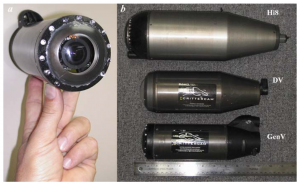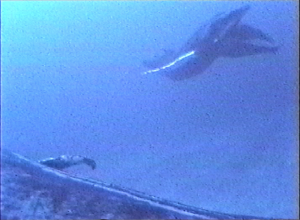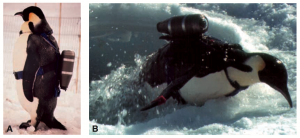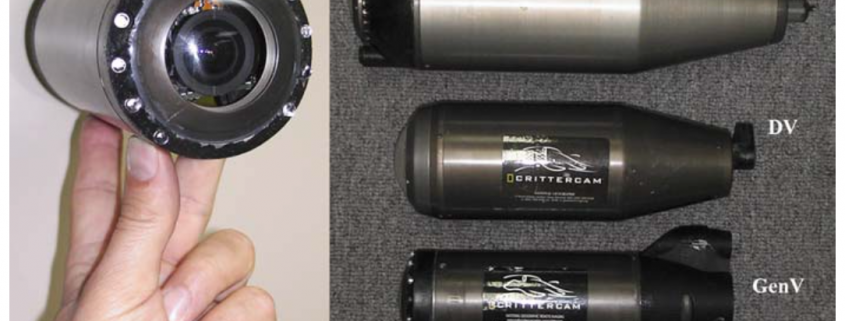Utilizing Crittercams to Study Animal Behavior
By Christopher Brown, RJD Intern
Two traditional techniques utilized by scientists to study animal behavior include observing wildlife species held in captivity and observing wildlife species in their natural habitats. However, there are limitations to both techniques. Animals that are held in captivity may not exhibit the same behaviors of individuals from the same species observed in the wild, and certain wildlife species may even adopt new behaviors while being held in captivity. Animals that are observed in their natural habitats may never become fully habituated with human observers, may practice specific behaviors that are difficult to observe due to climatic conditions or geographic location, or may be to elusive for scientists to locate. One of the greatest limitations scientists face is the physical inability to follow and observe wildlife species throughout a marine environment for extended periods of time.
Roughly forty years ago, marine scientists began attaching instruments to marine vertebrates in order to assess habitats, behavior, and physiology in marine environments. The instruments collected data on diving behavior using Time Depth Recorders (TDR), location and geographic range using radio satellite and GPS, and foraging and physiology using stomach temperature and heart rate monitors (Marshall, 1998). Even though each of these instruments collected useful information on habitat use, behavior and physiology, marine scientists were still left to infer behavior due to the inability to directly observe marine vertebrates in their natural environments.
In 1986, marine biologist and filmmaker Greg Marshall was diving off the coast of Belize when a shark approached him. The encounter was brief, and the shark quickly swam away, but not before Greg noticed a remora attached to the shark’s stomach. Greg was inspired to build a camera that could take the place of the remora, and provide scientists with the ability to observe the shark’s behavior for extended periods of time with only brief intervals of human contact. In 1987, Greg Marshall deployed the first National Geographic Crittercam on a sea turtle. The sea turtle behaved normally following the attachment of the Crittercam, indicating that the newly designed device had the potential to advance animal behavior research on a multi-species scale.

a) Frontal view of a GenV Crittercam system b) Size comparison between GenV, digital video, and Hi8 Crittercam systems (Marshall, 2007).
Crittercam is an animal-borne image documenting and data logging system that allows marine scientists to collect video footage and environmental data for studying the behavior and ecology of marine vertebrates (Marshall, 1998). The Crittercam has been utilized to study the behaviors of sea turtles, sharks, penguins, whales, seals and sea lions (Marshall, 2007). Various techniques are used to temporarily attach the Crittercam to different wildlife species (Marshall, 2007). Epoxy patches are used to attach the Crittercam to pinnipeds and hard-shelled sea turtles. Suction cups are used to attach the Crittercam to whales, dolphins, and leatherback sea turtles. Clamps are used to attach the Crittercam to the dorsal fin of sharks, and a backpack harness has been used to strap the Crittercam to a penguin. Crittercams that are attached to marine vertebrates record all the video footage and environmental data within the device’s memory system, which means that scientists must retrieve the deployed Crittercam in order to access the collected information. The length of deployment depends on the specific research project and species being studied, and can last anywhere from several hours to several weeks. Before deployment, the computer system inside the Crittercam device is programmed to trigger a release mechanism at a specific time, under specific environmental conditions, or after a specific amount of video footage and data has been collected (Marshall, 2007). The Crittercam is then tracked and retrieved using the device’s onboard radio beacon.

View of a secondary escort Humpback Whale, inflating his pleats along the seafloor, from a Crittercam attached to the principal escort Humpback Whale (Herman, Elia YK, et al., 2007)
The video footage and environmental data collected by Crittercams has allowed marine scientists to further study the habitat use, foraging, reproductive and social behaviors, interspecific competition and other behavioral parameters of free-swimming marine vertebrates. Ponganis, P. J., et al. utilized a Crittercam to study the sub-ice foraging behaviors of emperor penguins trained to wear a harness. Video footage and depth profile recordings from an isolated dive hole revealed that the emperor penguins repeatedly dove to shallow depths (<50 meters), before ascending to the underside of the ice sheet to feed on fish (Ponganis, P. J., et al., 2000). At the end of each feeding interval, which lasted anywhere from one to several minutes, the emperor penguins again descended to shallow depths (<50 meters) before returning to the exit hole. An additional study by Herman, Elia YK, et al. utilized a Crittercam to study the competitive behaviors of humpback whales on their hawaiian wintering grounds, observing diving behaviors and micro-interactions between humpback whales deep below the ocean’s surface. Video footage revealed a variety of reproductive and social behaviors between primary and secondary escort humpback whales competing for a single female at depths >150 meters, including the inflation of pleats along the seafloor, threats, body strikes, and chasing (Herman, Elia YK, et al., 2007).

a) A backpack harness is used to attach a Crittercam to an Emperor Penguin b) An Emperor Penguin emerging from a dive hole wearing a Crittercam (Penguins, P.J., ET AL., 2000)
The research performed by Ponganis, P. J., et al. and Herman, Elia YK, et al. demonstrates that the Crittercam can be successfully deployed in extreme marine environments, ranging from artic conditions to ocean depths that are inaccessible to human observers. The Crittercam is an advanced piece of technology that, as it is further improved and developed, will allow marine scientists to continue studying animal behavior and ecology in more complex and dynamic marine environments. Currently, the application of Crittercams is limited to the size of the organism and species being studied. Therefore, Crittercams will become more applicable to a broader range of species as smaller animal-borne image documenting and data logging systems are designed and created.
References:
Herman, Elia YK, et al. “When whales collide: CRITTERCAM offers insight into the competitive behavior of humpback whales on their Hawaiian wintering grounds.” Marine Technology Society Journal 41.4 (2007): 35-43.
Marshall, G. J. (1998). Crittercam: An animal-borne imaging and data logging system. Marine Technology Society.Marine Technology Society Journal, 32(1), 11.
Marshall, Greg, et al. “An advanced solid-state animal-borne video and environmental data-logging device (“CRITTERCAM”) for marine research.” Marine Technology Society Journal 41.2 (2007): 31-38.
Ponganis, P. J., et al. “Sub-ice foraging behavior of emperor penguins.” Journal of Experimental Biology 203.21 (2000): 3275-3278.




Leave a Reply
Want to join the discussion?Feel free to contribute!